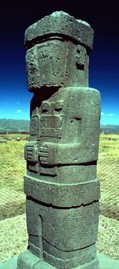10 Pieces of Art:
1. Beaker (kero)
Beakers like this one were used to consume chicha (corn beer) during religious ceremonies and played a very important role in maintaining the social and political structures of the region. All of the art displayed on the beaker can also be seen with classic Tiwanaku techniques. It was probably located in the coasted desert area, where the preservation conditions of the area was best for the raw materials this object required.
2. Ceremonial Knife (tumi)
Tumis are ceremonial knives that have been made on the Peruvian coast since at least the third century BC. They were made very delicately from gold, silver, and arsenical copper. Their main use was to cut the throat of sacrificial victims but were often put in the graves of important people.
3. Figure Holding Ceremonial Objects
In the Tiwanaku civilization, near the shore of Lake Titcaca, they have been known for their unique architecture and finely cut figurines. While the large figures could reach up to twenty-four feet in height, these small ones may have been used in private ceremonies conducted by upper-class families or clans. This figure has a large head with a plain cap and chin strap. It is holding two objects, possibly snuff trays, and a patterned kilt of stylized faces and squares covers the lower-half of the body.
4. Ornamental Plume or Pin
This rare decorated plume is decorated in Pukará style, illustrating how sophisticated and elaborate their designs can get. It seems to depict a ritual event where animals and humans alike participate. It is a possible animal sacrifice. The ornaments, like this, may have been worn in the headdress of an important individual, to show their superiority.
5. Snuff Tablet
In Tiwanaku culture, it was common to inhale "snuff" through small trays or tablets. People were often buried with paraphernalia and other objects, such as inhaling tubes, spatulas, small mortars, and pestles. The snuff was prepared with leaves, resin, and seeds of various plants dried and finely ground, and was used to treat many ailments.
6. Feline Incense Vessel
7. Large Anthropomorphic Figure
This figure still stands on the Kalasasaya Mound. It faces the entrance and the andesite stone was transported at least 100 kilometers and the sandstone was transported at least 20.
8. Jar in the Form of a Jaguar Head
This jar was most likely used to hold water and possibly other liquids in ceremonies and rituals. With the amount of detail that went in to the design of this jar, it is not hard to see that this would have been important to the culture.
9. Single Spout and Bridge Vessel
This object is similar to today's coffee pot in the way that it was used to pour various liquids for drinking. It was highly decorated and possibly used at rituals of dance.
10. The "Gate of the Sun"
This structure was the center to Tiwanaku life and culture. Many rituals took place here, as the sun was a very important object in Tiwanaku religion, and was worshipped as such.










No comments:
Post a Comment